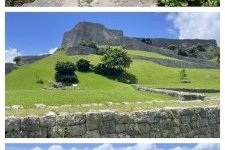
Visit June2023. It seems that most visitors of this site only visit the elements around Naha, the southern part of the Okinawa Island. Our Okinawa stay was three nights, and we visited all nine elements of this site. We picked up our rental car at the airport and drove immediately up to the northern part of the island. As we first visited the subtropical rainforests in the northern part of Okinawa (WHS), we approached these Gusukus of Ryukyu from north (or northeast).
The northernmost Gusuku is Nakijin-jô naturally became our first visit. Nakijin Castle Ruins are huge, probably the biggest site in this “collection”. It’s a ruin of a castle residing nicely on a hilltop and down the slopes in every direction. The walls are high and even though they probably are restored it gives a good impression of how it once was. In addition to the walls as part of the “main castle” there are living quarters and holy places around inside the outer walls. The surrounding area is lush green and on the hilltop it’s a nice rest for your eyes – looking all the way to the sea.
Next in line (although it’s far from a straight line) was Zakimi-jô which is a ruin of a castle as well. It is a little more than an hour drive from Nakijin. This site is probably the smallest site and the least interesting. It’s the only site without an admission fee, maybe because there is very little to see. It’s basically a ringed wall with nothing inside. There is something that looked like a museum on site, but we ignored it – in our quest to see all the sites.
Some 30-40 minutes further southeast is Katsuren-jô which is a third castle ruin with a ringed wall on a hilltop. Again, the same castle centre on the hilltop with living quarters and holy places inside the outer or lower walls. Very nice but second to Nakijin-jô.
Then 20-30 minutes southwest is Nakagusuku-jô, the fourth castle ruin. Again, the same pattern, a hilltop, and the slopes with the lower ringed wall at the foot of the hill. This one was a nice surprise, and squeezes in as the second best.
Another 20 minutes further south then we find ourselves in the outskirts of Naha. The royal garden of Shikinaen is our first non-castle ruin and thus a bit more interesting. This site played an important role in the diplomacy with China which was the major trading power at the time. It’s not a traditionally Japanese garden, but this wasn’t Japan at that time either. It’s mostly nice because it represents something else.
Our final goal this day was the holy site of Sêfa-utaki which is about half an hour to the west at the shore near Chinen, and again, something else. A video explaining the features of the site and how to behave, was good and necessary. The site was not deserted nor crowded, but you didn’t have to line up anywhere. In fact, none of the sites have been crowded so far. Matejicek has explained the site detailed so there is no more to add.
The next morning before leaving Okinawa we visited the three remaining sites, all near Nara. The Shuri castle with the Sonohyan-utaki and finally then Tamaudun royal mausoleum. All these sites are thoroughly described in previous reviews so it shouldn’t be necessary to repeat it.
The wooden palace at Shuri castle is still under restoration after the fire. We peeked through the window of the huge temporary building covering the area and could see the progress. They still have a long way to go.
We were lucky arriving at the time for the morning opening, so a small insight of the local old traditions was on display for us.
Every one of these Ryukyu sites have UNESCO plaques, information panels/folders in English, are reasonably priced and have nice paper tickets (except Zakimi-jô). The site fulfils the WHS Commandments (in our opinion).
Pictures show from top: Nakagusuku-jô, Katsuren-jô, Zakimi-jô.
### Randi & Svein Elias
More on
Comments
No comments yet.
